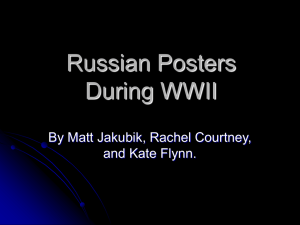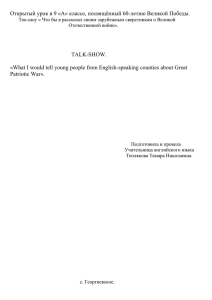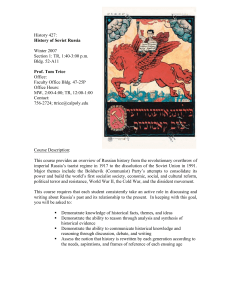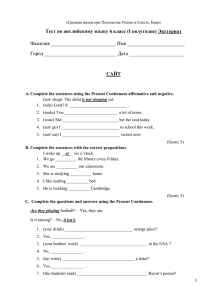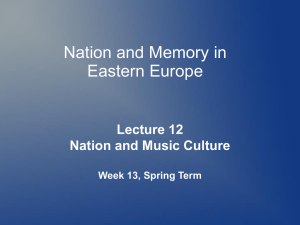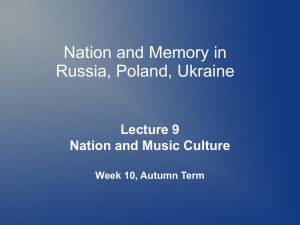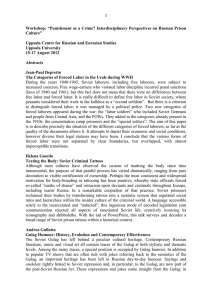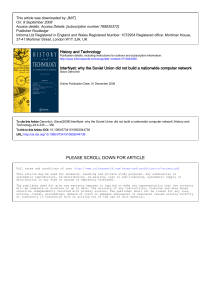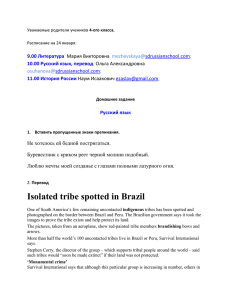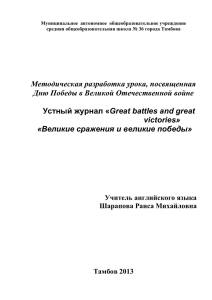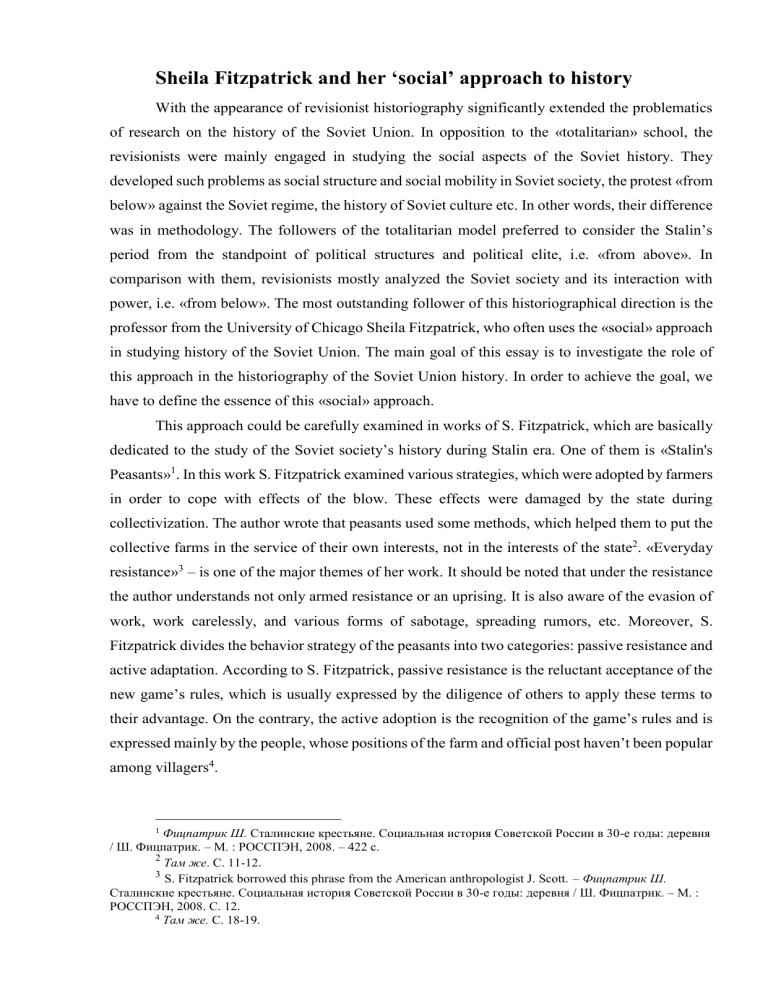
Sheila Fitzpatrick and her ‘social’ approach to history With the appearance of revisionist historiography significantly extended the problematics of research on the history of the Soviet Union. In opposition to the «totalitarian» school, the revisionists were mainly engaged in studying the social aspects of the Soviet history. They developed such problems as social structure and social mobility in Soviet society, the protest «from below» against the Soviet regime, the history of Soviet culture etc. In other words, their difference was in methodology. The followers of the totalitarian model preferred to consider the Stalin’s period from the standpoint of political structures and political elite, i.e. «from above». In comparison with them, revisionists mostly analyzed the Soviet society and its interaction with power, i.e. «from below». The most outstanding follower of this historiographical direction is the professor from the University of Chicago Sheila Fitzpatrick, who often uses the «social» approach in studying history of the Soviet Union. The main goal of this essay is to investigate the role of this approach in the historiography of the Soviet Union history. In order to achieve the goal, we have to define the essence of this «social» approach. This approach could be carefully examined in works of S. Fitzpatrick, which are basically dedicated to the study of the Soviet society’s history during Stalin era. One of them is «Stalin's Peasants»1. In this work S. Fitzpatrick examined various strategies, which were adopted by farmers in order to cope with effects of the blow. These effects were damaged by the state during collectivization. The author wrote that peasants used some methods, which helped them to put the collective farms in the service of their own interests, not in the interests of the state2. «Everyday resistance»3 – is one of the major themes of her work. It should be noted that under the resistance the author understands not only armed resistance or an uprising. It is also aware of the evasion of work, work carelessly, and various forms of sabotage, spreading rumors, etc. Moreover, S. Fitzpatrick divides the behavior strategy of the peasants into two categories: passive resistance and active adaptation. According to S. Fitzpatrick, passive resistance is the reluctant acceptance of the new game’s rules, which is usually expressed by the diligence of others to apply these terms to their advantage. On the contrary, the active adoption is the recognition of the game’s rules and is expressed mainly by the people, whose positions of the farm and official post haven’t been popular among villagers4. Фицпатрик Ш. Сталинские крестьяне. Социальная история Советской России в 30-е годы: деревня / Ш. Фицпатрик. – М. : РОССПЭН, 2008. – 422 с. 2 Там же. С. 11-12. 3 S. Fitzpatrick borrowed this phrase from the American anthropologist J. Scott. – Фицпатрик Ш. Сталинские крестьяне. Социальная история Советской России в 30-е годы: деревня / Ш. Фицпатрик. – М. : РОССПЭН, 2008. С. 12. 4 Там же. С. 18-19. 1 The similar topics S. Fitzpatrick investigates in other work – «Everyday Stalinism»5. In this book she wrote about the forms of action and survival strategies, which had the Soviet people in the era of Stalinism. Meanwhile, she, unlike other researchers, regard «Stalinism» as consequences of system and ideologies that have shaped the environment of the Soviet people of the Stalin era i.e. the whole complex of institutions, structures, rituals etc6. In this work the author illustrates the attitude of Soviet society to the Stalinist regime from two sides. On the one hand, the Soviet society supported the regime and power. According to S. Fitzpatrick, this part of society consisted of young people and the privileged strata, such as stakhanovites or proletarian nominees7, i.e., those segments who have learned the ideals of the Soviet Stalin era best of all. On the other hand, the significant part of the Soviet society did not support the regime, in which they lived. This part of the society rejected those principles and ideals, which the state tried to instill. The author shows this rejecting from two types. The first type of rejection was an understanding that to live in these conditions people can only accept them, at least outwardly. The second one was the open ridicule of the regime, but only in narrow circles, among people just like them8. That’s why S. Fitzpatrick often compares the relationship between Soviet society and the state with prisoners and jailers in jailhouses or pupils and teachers in schools. For a deeper understanding of the Soviet identity is devoted the book «Tear Off the Masks!»9. S. Fitzpatrick regarded the Soviet identity as effects that were designed by external cultural and social practices and norms. In this regard, there is no coincidence that the name of the book is «Tear Off the Masks!», because the author used the example of the masks and roles that people played throughout their life. For consideration the Soviet identity from this side, she used biographies, autobiographies, delations, etc. In other words, the author used such kinds of the historical sources, where the Soviet people wanted to hide their flaws and show themselves from the best side. Besides these historical sources, S. Fitzpatrick also engaged fiction, where she found the images that were the personification of the Soviet people. One of these images was Ostap Bender, the main character of the novels by I. Ilf and E. Petrov, who was portrayed as a crook that was forced because of the Soviet everyday life and performed a variety of tricks, subterfuge and theft in order to survive. To sum it up, it should be noted that in these three works of S. Fitzpatrick is traced a certain relationship, namely the «social» approach in studying history of the Soviet Union. She showed 5 Она же. Повседневный сталинизм. Социальная история Советской России в 30-е годы: город / Ш. Фицпатрик. – М. : РОССПЭН, 2008. – 336 с. 6 Там же. С. 10. 7 Там же. С. 268. 8 S. Fitzpatrick investigated in detail such kind of stories in her book, which would be examined next. 9 Она же. Срывайте маски!: Идентичность и самозванство в России XX века / Ш. Фицпатрик. – М. : РОССПЭН, 2011. – 375 с. that the Soviet society was not a real integrity and, accordingly, there was no single way of relationship between people and the state. S. Fitzpatrick showed in her works that this society had possessed a high mobility. It adjusted to the new conditions of life and tried to bypass state guidelines. As a result, she was able to show that the Soviet society was not passive, as the followers of the «totalitarian» school thought. These and many other works S. Fitzpatrick have helped to deepen our understanding of «Stalinism» and thus she has showed that there are a lot of issues in this area, which should be investigated in the future. Bibliography: 1. Фицпатрик Ш. Повседневный сталинизм. Социальная история Советской России в 30-е годы: город / Ш. Фицпатрик. – М. : РОССПЭН, 2008. – 336 с. 2. Фицпатрик Ш. Срывайте маски!: Идентичность и самозванство в России XX века / Ш. Фицпатрик. – М. : РОССПЭН, 2011. – 375 с. 3. Фицпатрик Ш. Сталинские крестьяне. Социальная история Советской России в 30-е годы: деревня / Ш. Фицпатрик. – М. : РОССПЭН, 2008. – 422 с.
